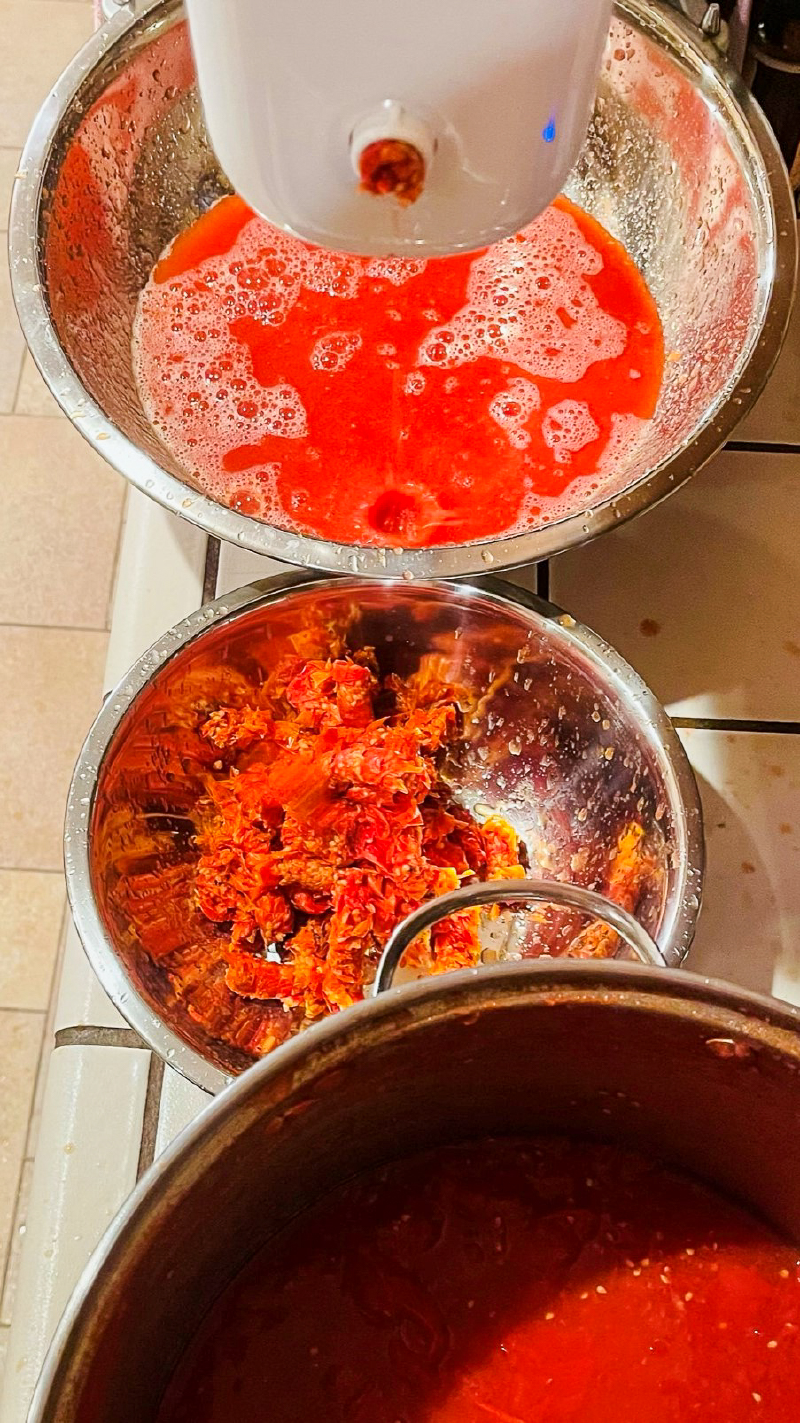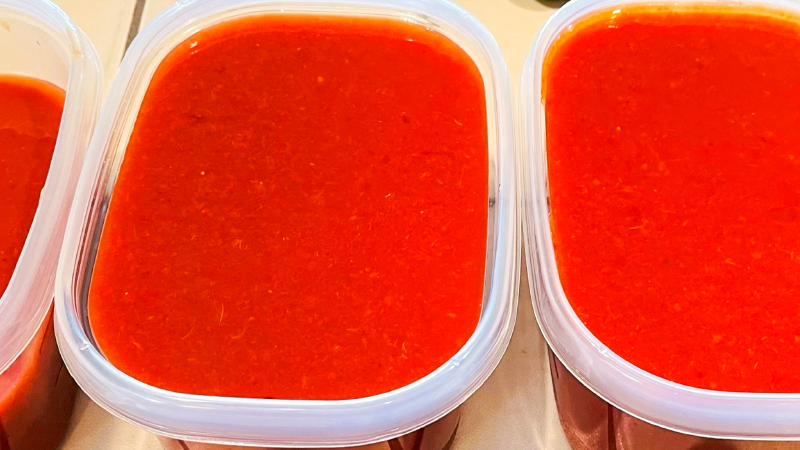Quickest Easiest Ways to Make Homemade Tomato Sauce with No Manual Peeling or Deseeding
Got too many tomatoes?
When I grow too many tomatoes, they start to rot very quickly when we can’t keep up with eating them all.
One way to save the tomatoes is to turn them into sauce.
Unfortunately, tomato sauce-making can turn into a time blackhole. Nowadays, who has the time to mess around when there’s an endless amount of other important work to be done?
So, the caveat to this process is that you already have an excess of tomatoes from somewhere (Your garden? Your family or friend’s garden? And so on.). Otherwise, it’s just not worth the time and energy cost to buy tomatoes from the store and turn it to sauce.
Honestly, canned tomato sauce from the store is a nearly identical product to homemade tomato sauce if you thoroughly deskin and deseed your sauce. And this is coming from someone who is very particular about her food and where it comes from.
Quickest Methods for Tomato Sauce-making – Use tools, Do no manual work
In order from least to most time and effort.
1. Blenders
If you want your tomato sauce to be slightly different and a more “homemade” texture to the stuff you can get from the store, it’s probably best to use a blender. Coincidentally, blenders are the lowest effort tool you can use.
The easiest blenders to use and clean are stick-type blenders. Tiny pieces of skin and some seeds will remain after blending, so the texture results in more of a homemade feel. My stick blender is my go-to since it’s just so easy even though I also have a regular Vitamix blender. I don’t care about having seeds or other bits in my sauce – more vitamins and fiber as well.
You can get a similar “homemade feel” effect by using your everyday regular upright blender, but there’s usually a lot of clean-up involved and you have to blend in multiple batches if you have a lot of tomato sauce. The stick blender allows for blending in one batch which is just awesome, and it saves so much time.
If you don’t like seeing pieces of seeds or skin and prefer a more homogenous product, the next best thing to use are powerful blenders such as Vitamix and Blendtec.
I can only vouch for the basic Vitamix 5200 since that’s what I have, it’s simple to clean – no disassembling parts and blades. The time consuming part is having to wait for your tomato sauce to cooldown a bit and having to do it in multiple batches if you have more than a Vitamix container’s worth of sauce.
2. Tomato strainer machine or attachment to your KitchenAid mixer
If you prefer regular tomato sauce like what you can get at the grocery store, then a tomato strainer is great for this.
I use the KitchenAid tomato strainer model KSMFVSP and it requires the food grinder attachment model KSMFGA. I’m so glad to have found such a thing, because previously, I was attempting to use a hand strainer to strain the sauce manually. I have since discovered how much time I’ve wasted!
The KitchenAid strainer goes through cooked tomatoes very quickly, and if the seed/skin output is too watery and fleshy, you can put it into the machine again to strain it more. I make it go a max of 3 times, because I also found if you restrain the output too many times, it can build up, get stuck and possibly break your straining cone if you don’t notice.
I can strain my whole stock pot worth of cooked tomatoes in around 10 minutes, about 2 gallons.
I put this tool below blenders because it definitely takes more time. It can get messy too, and there’s a bit of a learning curve.
For easy cleaning of the strainer tool, I take it all apart and soak the parts all in my stock pot filled with water. This softens the tomato bits, then they easily dislodge from the strainer cone and from inside the long screw part.

I would –not– use any other tools aside from what I mentioned.
The Process to actually make homemade tomato sauce
The actual process of how I make my tomato sauce is dead simple. I use any types of tomatoes – cherry, slicing, plum, whatever.
I usually just clean my tomatoes, cut out the bad parts, toss everything in the pot, and cook just until everything is soft. It’s not meant to be more complicated than that.
There are some things I check that are automatic for me since I’ve been doing this for a while. Here are some more details of what I do for more guidance:
Clean your tomatoes, cut off stems, blemishes, and parts you wouldn’t want to eat.
Toss cleaned tomatoes into a pot. I usually toss in mostly whole tomatoes, some cut. Put on your pot lid, turn on medium heat on your stove.
After 5 minutes, or when the pot heats up, make sure there’s liquid forming on the very bottom of the pot, else tomatoes may burn if there’s no liquid and it’s too hot. If most of the tomatoes are turning soft on the bottom and there’s still no liquid layer on the bottom of the pot, add only enough water to barely cover the bottom of the pot to prevent burning (I never end up putting in water).
Make sure the pot lid is on and keep cooking the tomatoes on medium heat, the steam should cook the top layers of tomatoes and liquid from the tomatoes will accumulate on the bottom.
I don’t squish or smash the tomatoes while they’re cooking or after. That’s work for your tools. See note below about possibly needing to leave most of your tomatoes whole.
I usually cook on medium heat for about 30 minutes, or until the tomatoes on top turn soft and their skin can peel off.
Optional water drainage step if you’re using high water content tomatoes. See same note below.
Process your cooked tomatoes with tool of your choice. If your sauce is mostly paste-type tomatoes, you can start processing the cooked hot tomatoes as soon as you’re comfortable handling the tomatoes with your tools. The cooler the tomatoes, the better for your upright blender or KitchenAid – temperature for stick blender doesn’t matter.
Note: If you use high water content tomatoes such as any slicing or beefsteak tomatoes, and you want to use the sauce for pasta rather than soup, it’s best to leave the tomatoes whole while they’re cooking. It’s ok if they’re cut but try to not smash them further. That way, after they’re done cooking, the pot of cooked tomatoes can sit a few hours or overnight –put the pot in the fridge when you can– a lot of the water from the tomatoes separates well. Most of the solids settle to the bottom of the pot. Then you can ladle out as much “tomato” water out of the pot as you can. Your sauce will be more concentrated without having to reduce the water by evaporation and cooking for long. Leaving the pot of cooked tomatoes overnight also has the benefit of cooling the tomatoes without extra effort, and makes for easy handling during the processing step.
If you’re making soup, or don’t mind the volume or thinness of the sauce, then the extra water reduction/evaporation step doesn’t matter.
I find cooking the tomatoes before processing with the KitchenAid tomato strainer or blender to be easier on the machines and on myself, and it ultimately saves time. There’s a lot of chopping to do to if you want to strain or blend whole raw tomatoes, and the strainer seems to work better/faster with cooked tomatoes. And you can’t reduce the extra water easily as you can with cooked tomatoes.
This results in a decent tomato sauce that you can use for most things. And you don’t have to spend the time or energy cost to simmer the sauce all day to reduce it.
I mainly use this tomato sauce for soups and pasta.
